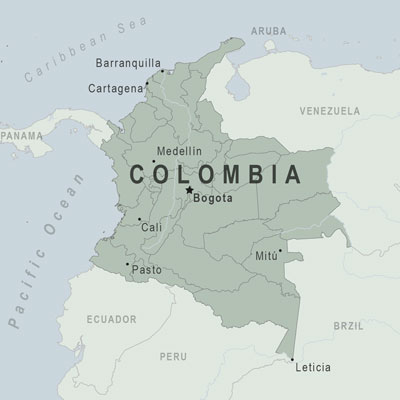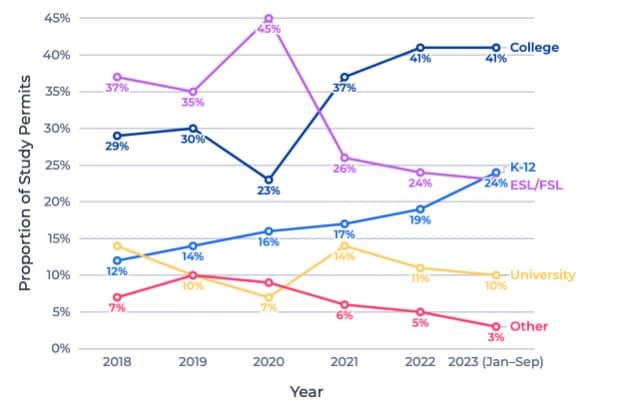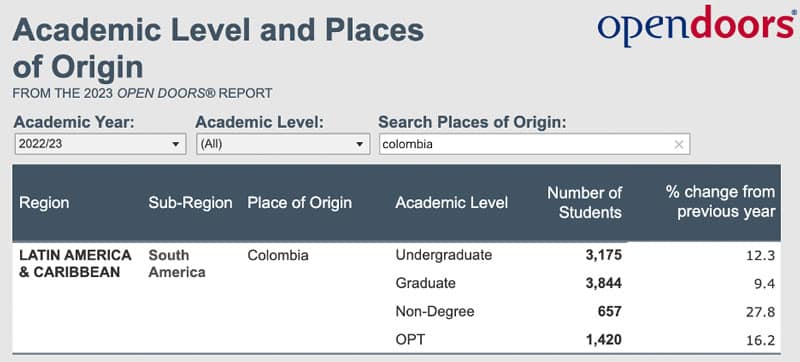FAST FACTS
Capital: Bogotá
Population: 53 million (2024)
Youth population: 17% of the population is aged 15–24
Median age: 32.7
GDP: US$386 billion (2024)
Currency: Colombian peso (COP)
Language: Spanish
Main language of instruction: Spanish in public schools and universities, though some Colombian universities offer courses taught in English.
English proficiency: “Low” but climbing.
Religion: Christian, predominantly Roman Catholic.
Geography: Colombia is in northwestern South America, bordered by the Pacific Ocean and the Caribbean Sea and by the countries of Ecuador, Peru, Brazil, Venezuela, and Panama.
Academic year: February to November, with some local variations.
Outbound students: At least 75,000 in higher education, with tens of thousands abroad for English-language studies as well.
Top fields of study for Colombians looking at study abroad: According to the US International Trade Administration, Colombian students are drawn to programmes in business administration, management, finance, banking, marketing, and engineering.

Along with Brazil, Colombia is a South American outbound student market that is firmly on the radar of many recruiters going into 2025. It has been sending ever-greater numbers of students abroad for all levels of study, from higher education to vocational training, and from K-12 to English-language studies.
There are about 20,000 Colombians studying in Argentina and 18,000 in Spain. Last year, there were some rumblings that Argentina would lose most, if not all, its Colombian students because of a government proposal to end free tuition for international students. This proposal was voted down in February 2024.
English-language destinations have seen tremendous growth from Colombia: Canadian institutions (colleges, universities, schools, and English-language programmes lasting six months or more) hosted 15,200 Colombian students in 2023 (+23% y-o-y), while US colleges and universities hosted 9,100 (+13%).
Australia saw 39,720 Colombians on study visas in 2023 (+43% y-o-y). The majority (73%) were enrolled in English-language programmes (ELICOS). France and Germany each host about 4,000 Colombian students in higher education institutions.
Levels of study
While Australia’s stream of Colombian students flows mostly to ELICOS programmes, the vocational sector (VET) is also popular – as shown in the chart below. A fascinating bit of research from several years ago demonstrated the great extent to which the ELICOS sector fuels the health of other sectors in Australia over time. Colombian students have generally low English-language proficiency and so it bodes well for all Australian universities and VET providers that so many of them are enrolling in language courses and thus preparing themselves for success in further studies.

Colombian students are well distributed across the Canadian education landscape, and as illustrated in the following chart from ApplyBoard, college courses are the main draw. However, Canadian colleges could lose some traction in the market now that the partners of international college students are no longer eligible for a work visa.

In the US, Colombian students are well represented at both the undergraduate and graduate levels, as shown below in IIE Open Doors data for 2022/23. Overall, Colombia was one of the fastest growing higher education markets for the US that year (+12.6%), exceeding growth from the top South American market, Brazil (+7.6%). There are also close to 3,000 Colombian students in US Intensive English Programmes (IEPs), and Colombia is the 9th largest source of students for that sector.

Key considerations when recruiting in Colombia
1. There is clearly great potential for outbound student flows to expand further in Colombia. Foreign education credentials continue to be a huge advantage in a country where the unemployment rate is relatively high (around 10%, compared with Argentina’s 7.5% and Brazil’s 8%). As the US Trade Administration notes about Colombia, “it is difficult to obtain a high-level position within the government or an important national or multinational company without proficient English skills and/or a graduate degree … Moreover, a degree from a U.S. university can serve to make job applicants that much more competitive in the Colombian workplace.”
There is another, very unfortunate reason that the demand for study abroad in Colombia is especially high right now. The security situation in the country has once again deteriorated after a few years of respite. Not only are thousands of Colombians fleeing their country, but Colombia is also home to “the third largest population of refugees and other people in need of international protection worldwide,” according to the UNHCR. Many of those refugees are from Venezuela.
2. Low English-language proficiency is a serious issue affecting the ability of Colombian students to be eligible for, or to study successfully, in English-taught higher education programmes abroad. Younger Colombians are especially likely to be challenged in this way: the EF English-language Index puts 18-20-year-old Colombians in the “very low” category, with older generations scoring better.
Savvy institutions and governments are addressing Colombians’ generally low English fluency through initiatives designed to either help them gain proficiency or translate marketing and communications into Spanish. For example, the US Embassy in Bogota has launched technology projects such as Ellucian’s 24/7 virtual advising platform and offers small scholarships for English-language studies.
Similarly, Austrade launched the Study Experience Platform in Spanish and Portuguese for Latin American students in 2022, and this gateway to Australian studies has been crucial to driving interest in Colombia (and Brazil). Study Experience offers virtual events such as webinars, masterclasses, and live chats and offers Latin American students the ability to:
- “Watch weekly videos from real students in Australia.
- Find out about exclusive scholarships.
- Join live events every week.
- Receive exciting news from the Australian government firsthand.”
Within a few months of its launch date, the Study Experience platform had already achieved remarkable success. As reported by Mirage News in April 2022 (three months post-launch):
- “1 million people have viewed Australian education messaging due to a regional PR campaign.
- More than 193,0000 visitors have interacted with the platform with over 22,000 registered users.
- Over 1000 qualified leads have been provided to clients, with at least one Confirmation of Enrolment issued.
- 5853 people participated in 16 online events.”
ApplyBoard emphasises the importance of English-language assistance for those recruiting in Colombia by offering this advice:
“First and foremost for institutions looking to build their Colombian enrollment, we recommend offering more integrated English learning programs with curriculum. Providing more language pathway resources is crucial to meeting the needs of these students. And because the age-related proficiency gap exists throughout Latin America, investments toward bolstering these resources will help students from a multitude of source countries.”
3. Financial challenges are a significant barrier for many prospective Colombian students. Colombia is among the least equal societies in the world in terms of income distribution. While students attending private bilingual schools may not need financial assistance, many other students will. About 36% of the population falls below the poverty line, and about 60% of Colombians live on less than USD$10 a day.
Even a little financial assistance can go a long way. For example, EducationUSA offers “Opportunity Funds” for “highly qualified students who are likely to be awarded full financial support from accredited U.S. universities but who do not have the financial resources to cover the up-front costs related to applying and obtaining admission.”
The model is fascinating: “Over the course of approximately one year, selected students work closely with an EducationUSA adviser and with the cohort of other Opportunity Fund students to prepare and submit applications to up to eight U.S. universities where they have a strong chance of receiving a full scholarship from the university to cover tuition and living expenses.”
The Opportunity Fund serves several purposes: (1) it helps bright, but relatively poor, Colombian students to gain admission to top US universities, (2) it helps US universities to recruit students with the best chance of success, and (3) it helps the US as a whole to attract the kind of international students who are most likely to enrichen the US economy if they immigrate after completing their studies.
Institutions that do not factor in the financial constraints of many Colombian students stand to lose a significant segment of the potential market. When Colombian students were asked why they were refused a Canadian study permit in 2021/22, 36% said that it was partly due to insufficient finances.
ApplyBoard notes:
“While this percentage does not seem high, it’s important to keep in mind that students who know or believe they don’t have the financial resources to study abroad will often defer applying. As a result, this refusal percentage does not fully represent the price sensitivity of prospective students, particularly for a country experiencing currency devaluation like Colombia.”
4. Dual degrees and academic collaborations are in demand. Germany, for example, has nearly active 280 higher education cooperation projects with Colombia, whether through researcher exchanges or through scholarships. Canada has also become more interested in partnering through exchanges, internships, scholarships, and research collaborations.
In Colombia, there are main two scholarships organisations: the Colombian Institute for Educational Loans and Technical Studies Abroad (ICETEX) and COLFUTURO. ICETEX’s model is providing funding for students at the undergraduate or graduate levels – either in Colombia or abroad, while COLFUTURO is totally dedicated to financial aid for study abroad. The US International Trade Administration reports that “In 2022, COLFUTURO awarded 1,534 loan-scholarships for master’s and Ph.D. programs, with 311 of those being for programs in the United States.”
Where are the students?
As in other student markets, IB schools are good points of access to bright Colombian students who are interested in higher education studies abroad. As per EducationFairs.net, these schools include:
In terms of higher education, the Government of Alberta provides an excellent resource on how the system is administered in Colombia. Here is an excerpt:
“Currently, higher education consists of the following types of institutions: professional technical institutions, technological institutions, technological schools, university institutions and universities. The most important characteristic that sets the universities apart from other post-secondary institutions is the emphasis on research activities.
The obligatory licensing of institutions and registration of programs should not be confused with accreditation, which is voluntary in Colombia. An institution can be fully authorized to offer a non-accredited program. The National System of Accreditation (Sistema Nacional de Acreditación), maintains a searchable online database of information about all registered higher education institutions and programs.
Accreditation is awarded on a program-by-program basis, starting at the undergraduate level. The CNA maintains a list of all accredited programs. The ultimate level of accreditation pertains to the entire institution and is separate from the accreditation of individual programs.”
The US International Trade Administration offers this guidance as well:
“At the higher education level, private universities also offer important recruitment opportunities for undergraduate and graduate programs. U.S. universities should make initial contact with the office of foreign relations in each university in order to introduce the U.S. university and its programs and areas of specialization to prospective students looking to expand their opportunities abroad.”
Several Colombian universities feature in the QS Top 500 World University Rankings, and over 50 are in the Top 400 for Latin America and the Caribbean.
For additional background, please see:
Source